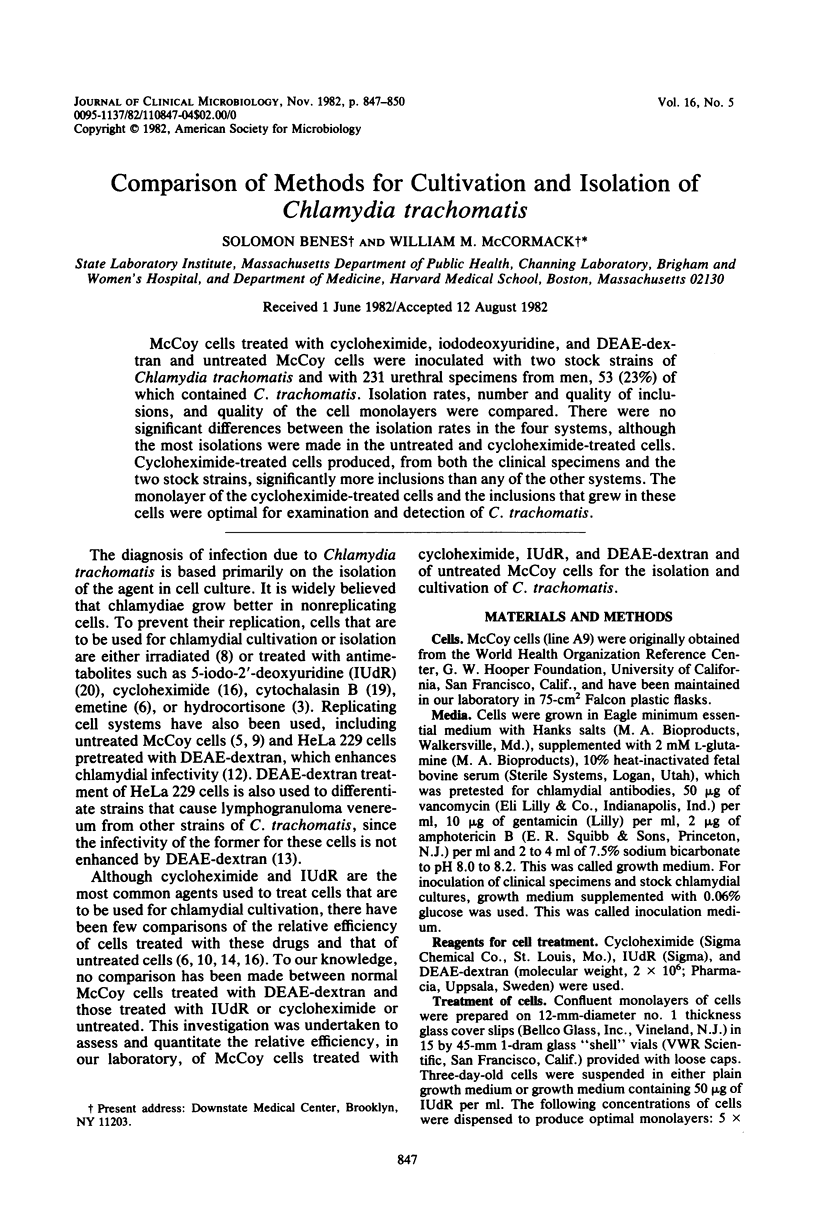Abstract
McCoy cells treated with cycloheximide, iododeoxyuridine, and DEAE-dextran and untreated McCoy cells were inoculated with two stock strains of Chlamydia trachomatis and with 231 urethral specimens from men, 53 (23%) of which contained C. trachomatis. Isolation rates, number and quality of inclusions, and quality of the cell monolayers were compared. There were no significant differences between the isolation rates in the four systems, although the most isolations were made in the untreated and cycloheximide-treated cells. Cycloheximide-treated cells produced, from both the clinical specimens and the two stock strains, significantly more inclusions than any of the other systems. The monolayer of the cycloheximide-treated cells and the inclusions that grew in these cells were optimal for examination and detection of C. trachomatis.
Full text
PDF



Selected References
These references are in PubMed. This may not be the complete list of references from this article.
- BOVARNICK M. R., MILLER J. C., SNYDER J. C. The influence of certain salts, amino acids, sugars, and proteins on the stability of rickettsiae. J Bacteriol. 1950 Apr;59(4):509–522. doi: 10.1128/jb.59.4.509-522.1950. [DOI] [PMC free article] [PubMed] [Google Scholar]
- Bushell A. C., Hobson D. Effect of cortisol on the growth of Chlamydia trachomatis in McCoy cells. Infect Immun. 1978 Sep;21(3):946–953. doi: 10.1128/iai.21.3.946-953.1978. [DOI] [PMC free article] [PubMed] [Google Scholar]
- Catalan F., Edlinger E., Siboulet A., Burtchaell S., Ouizman E. Adaptation à la pratique médicale courante et à l'épidémiologie des nouvelles méthodes d'isolement des Chlamydia. Ann Microbiol (Paris) 1978 Apr;129(3):329–339. [PubMed] [Google Scholar]
- Csángó P. A. Chlamydia trachomatis from men with non-gonococcal urethritis. Simplified procedure for cultivation and isolation in replicating McCoy cell culture. Acta Pathol Microbiol Scand B. 1978 Aug;86(4):257–259. doi: 10.1111/j.1699-0463.1978.tb00041.x. [DOI] [PubMed] [Google Scholar]
- Evans R. T., Taylor-Robinson D. Comparison of various McCoy cell treatment procedures used for detection of Chlamydia trachomatis. J Clin Microbiol. 1979 Aug;10(2):198–201. doi: 10.1128/jcm.10.2.198-201.1979. [DOI] [PMC free article] [PubMed] [Google Scholar]
- GORDON F. B., QUAN A. L. ISOLATION OF THE TRACHOMA AGENT IN CELL CULTURE. Proc Soc Exp Biol Med. 1965 Feb;118:354–359. doi: 10.3181/00379727-118-29841. [DOI] [PubMed] [Google Scholar]
- Gordon F. B., Dressler H. R., Quan A. L., McQuilkin W. T., Thomas J. I. Effect of ionizing irradiation on susceptibility of McCoy cell cultures to Chlamydia trachomatis. Appl Microbiol. 1972 Jan;23(1):123–129. doi: 10.1128/am.23.1.123-129.1972. [DOI] [PMC free article] [PubMed] [Google Scholar]
- Hobson D., Johnson F. W., Rees E., Tait I. A. Simplified method for diagnosis of genital and ocular infections with Chlamydia. Lancet. 1974 Sep 7;2(7880):555–556. doi: 10.1016/s0140-6736(74)91879-0. [DOI] [PubMed] [Google Scholar]
- Johnson F. W., Chancerelle L. Y., Hobson D. An improved method for demonstrating the growth of Chlamydiae in tissue culture. Med Lab Sci. 1978 Jan;35(1):67–74. [PubMed] [Google Scholar]
- Johnson L., Harper I. A. Isolation of chlamydia in irradiated and non-irradiated McCoy cells. J Clin Pathol. 1975 Dec;28(12):1003–1004. doi: 10.1136/jcp.28.12.1003. [DOI] [PMC free article] [PubMed] [Google Scholar]
- Kuo C., Wang S., Grayston J. T. Differentiation of TRIC and LGV organisms based on enhancement of infectivity by DEAE-dextran in cell culture. J Infect Dis. 1972 Mar;125(3):313–317. doi: 10.1093/infdis/125.3.313. [DOI] [PubMed] [Google Scholar]
- Kuo C., Wang S., Wentworth B. B., Grayston J. T. Primary isolation of TRIC organisms in HeLa 229 cells treated with DEAE-dextran. J Infect Dis. 1972 Jun;125(6):665–668. doi: 10.1093/infdis/125.6.665. [DOI] [PubMed] [Google Scholar]
- La Scolea L. J., Jr, Keddell J. E. Efficacy of various cell culture procedures for detection of Chlamydia trachomatis and applicability to diagnosis of pediatric infections. J Clin Microbiol. 1981 Apr;13(4):705–708. doi: 10.1128/jcm.13.4.705-708.1981. [DOI] [PMC free article] [PubMed] [Google Scholar]
- O'Neill J. J., McLean B. M., Hambling M. H. Isolation of chlamydiae in untreated and Cytochalasin B treated McCoy cells. J Clin Pathol. 1978 Feb;31(2):183–184. doi: 10.1136/jcp.31.2.183. [DOI] [PMC free article] [PubMed] [Google Scholar]
- Ripa K. T., Mårdh P. A. Cultivation of Chlamydia trachomatis in cycloheximide-treated mccoy cells. J Clin Microbiol. 1977 Oct;6(4):328–331. doi: 10.1128/jcm.6.4.328-331.1977. [DOI] [PMC free article] [PubMed] [Google Scholar]
- Sompolinsky D., Richmond S. Growth of Chlamydia trachomatis in McCoy cells treated with cytochalasin B. Appl Microbiol. 1974 Dec;28(6):912–914. doi: 10.1128/am.28.6.912-914.1974. [DOI] [PMC free article] [PubMed] [Google Scholar]
- Wentworth B. B., Alexander E. R. Isolation of Chlamydia trachomatis by use of 5-iodo-2-deoxyuridine-treated cells. Appl Microbiol. 1974 May;27(5):912–916. doi: 10.1128/am.27.5.912-916.1974. [DOI] [PMC free article] [PubMed] [Google Scholar]
- Yoder B. L., Stamm W. E., Koester C. M., Alexander E. R. Microtest procedure for isolation of Chlamydia trachomatis. J Clin Microbiol. 1981 Jun;13(6):1036–1039. doi: 10.1128/jcm.13.6.1036-1039.1981. [DOI] [PMC free article] [PubMed] [Google Scholar]


